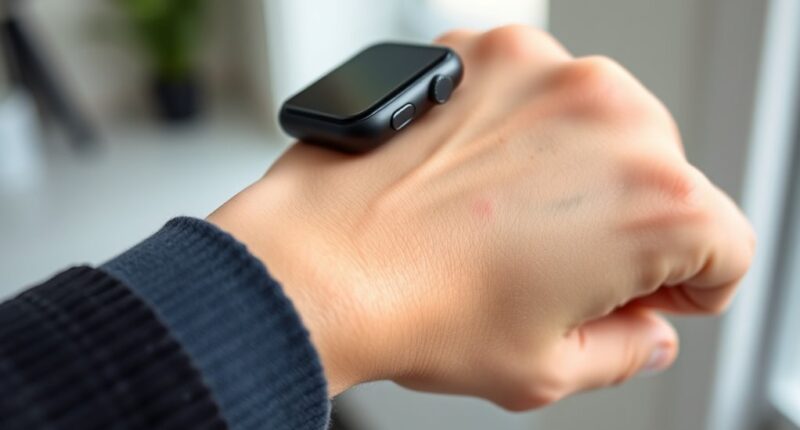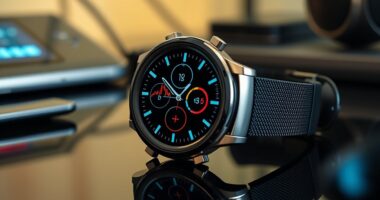To prevent smartwatch strap rash, opt for hypoallergenic materials like silicone, nylon, or surgical-grade metals, and make sure straps are clean and dry. Adjust the fit so it’s snug but not tight and switch straps regularly to reduce sweat buildup. Allow your skin to breathe by taking breaks and applying protective barriers or soothing lotions if irritation occurs. Follow these tips to keep your skin healthy, and you’ll discover more ways to stay comfortable with your smartwatch.
Key Takeaways
- Choose hypoallergenic straps made of silicone, nylon, or surgical-grade metals to reduce skin irritation.
- Clean your strap regularly with mild soap and water, and dry completely before rewearing.
- Ensure the strap fits snugly but not too tight to allow skin to breathe and prevent friction.
- Rotate straps frequently and avoid prolonged use of the same one to minimize sweat and dirt buildup.
- Use breathable materials and apply skin barriers or soothing creams to protect sensitive skin from friction and moisture.
Choose Hypoallergenic Strap Materials
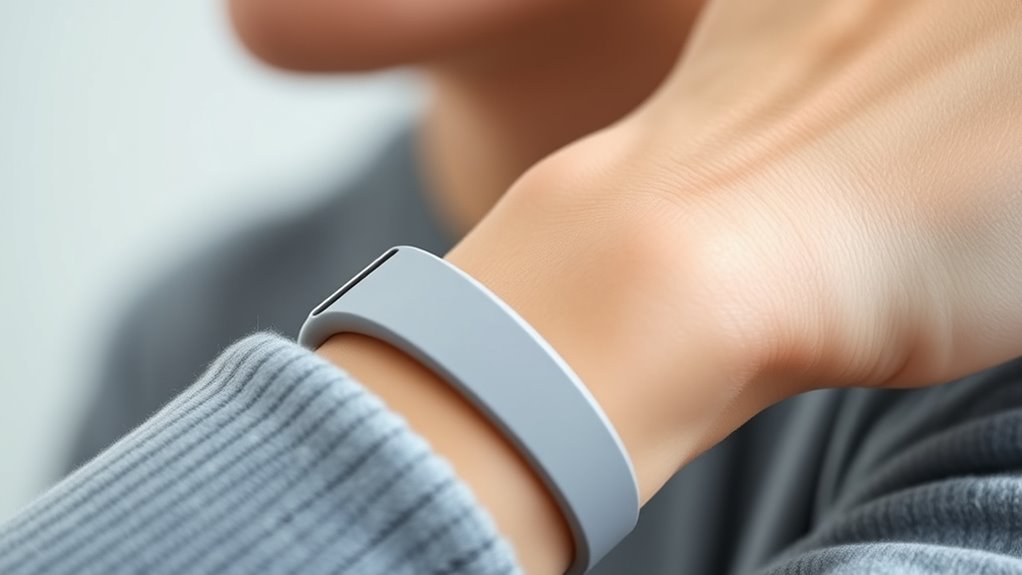
Choosing hypoallergenic strap materials is essential to prevent skin irritation and rash caused by smartwatch wear. If you have metal allergies, steer clear of straps made with nickel or other common allergens, which can trigger reactions. Instead, opt for hypoallergenic metals like titanium or surgical-grade stainless steel, known for their skin-friendly properties. Synthetic materials, such as silicone or silicone blends, are also excellent choices because they’re less likely to cause irritation and are easy to clean. Look for straps labeled as hypoallergenic or designed specifically for sensitive skin. By selecting the right materials, you reduce the risk of rash and discomfort, ensuring you can enjoy your smartwatch without skin issues. Always prioritize materials proven to be gentle and compatible with sensitive skin. Additionally, choosing skin-friendly materials can help minimize skin reactions and improve overall comfort during extended wear. Incorporating hypoallergenic options into your accessories can further enhance skin safety and comfort. Being aware of air quality and choosing materials that do not trap pollutants can also contribute to healthier skin.
Clean Your Watch and Strap Regularly
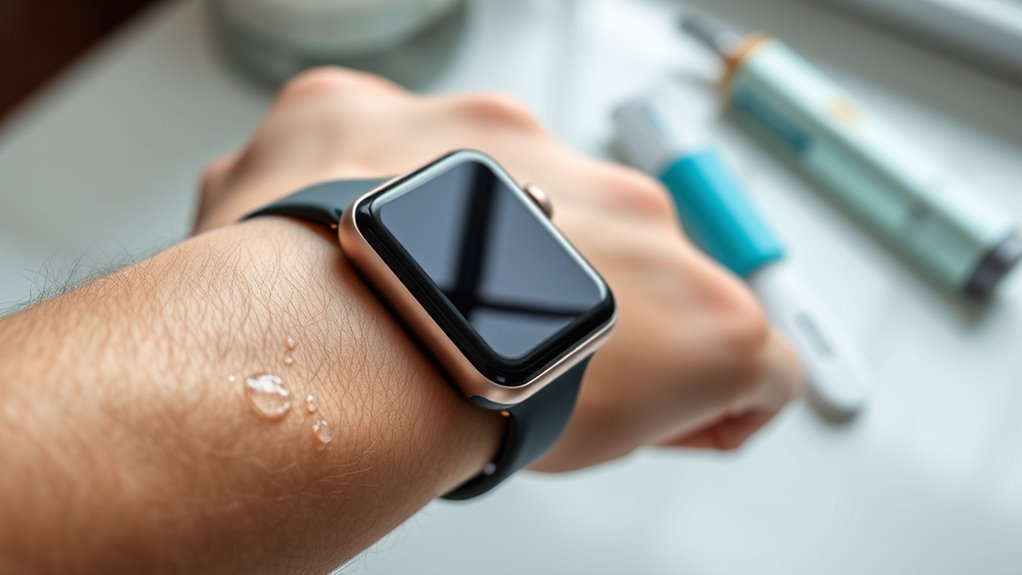
Regularly cleaning your smartwatch and its strap is one of the most effective ways to prevent skin irritation and rash. Proper smartwatch maintenance keeps dirt, sweat, and oils from building up, which can cause irritation. To keep your watch strap styles clean and skin-friendly, follow these steps:
- Remove the strap from your watch and wash it with mild soap and water.
- Use a soft brush or cloth to gently scrub dirt from textured or fabric straps.
- Wipe the watch face and case with a damp cloth, avoiding excessive moisture.
- Let everything dry completely before reassembling to prevent mold or bacteria growth.
- Incorporate regular cleaning routines, especially if you notice increased sweating or skin sensitivity, to maintain hygiene standards and prevent rash development. Regular cleaning also reduces the accumulation of bacteria and fungi, which can contribute to skin irritation. Staying aware of skin sensitivity can help you identify when more frequent cleaning is necessary to prevent discomfort. Additionally, using antimicrobial wipes can help further reduce bacteria buildup on your device.
Consistent cleaning minimizes skin contact with irritants and prolongs your smartwatch’s lifespan. A simple routine ensures comfort and reduces rash risk.
Allow Your Skin to Breathe
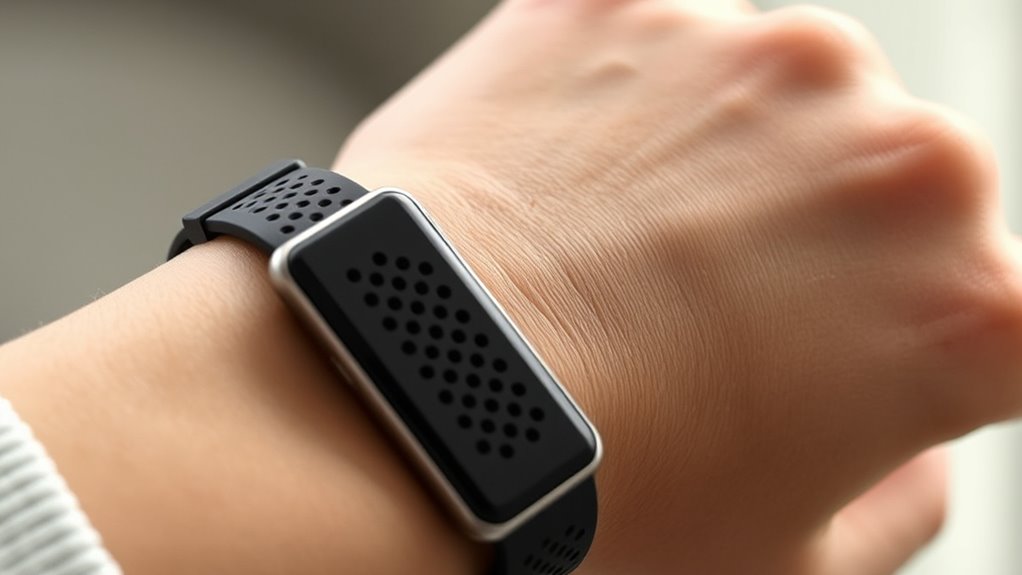
You should choose breathable materials for your smartwatch strap to reduce sweat buildup. Limiting how long you wear your watch each day also helps your skin stay dry and healthy. Giving your skin a break promotes better airflow and prevents irritation. Incorporating inspirational quotes about fatherhood into your routine can also help you develop better awareness of your body and skin health.
Choose Breathable Materials
Since your skin needs to breathe to stay healthy, selecting breathable materials for your smartwatch strap is essential. Opting for fabrics that promote airflow helps prevent irritation and rash. Consider these options:
- Silicone or rubber – lightweight and flexible, suitable for active lifestyles.
- Nylon or woven fabrics – breathable and comfortable, aligning with current fashion trends.
- Leather with perforations – stylish and allows better air circulation.
- Mesh or breathable synthetic materials – designed with technological features to enhance ventilation.
Choosing straps made from these materials keeps your skin dry and reduces irritation. Plus, they fit seamlessly into your fashion-forward wardrobe while supporting the latest technological trends. Remember, a breathable strap isn’t just about comfort; it’s about protecting your skin from rash and discomfort.
Limit Wear Time
Allowing your skin to breathe by limiting how long you wear your smartwatch each day is essential for preventing rash and irritation. Daily wear can trap sweat and bacteria against your skin, increasing the risk of irritation and compromising strap longevity. By taking breaks and removing your smartwatch periodically, you give your skin a chance to recover and stay dry. This simple step reduces friction and prevents buildup that can cause rash. Keep track of how long you wear your device, aiming for breaks every few hours. Not only does this help your skin, but it also extends the lifespan of your strap, preventing unnecessary wear and tear. Limiting wear time is an easy, effective way to protect your skin and keep your smartwatch in good condition.
Adjust Strap Fit for Comfort
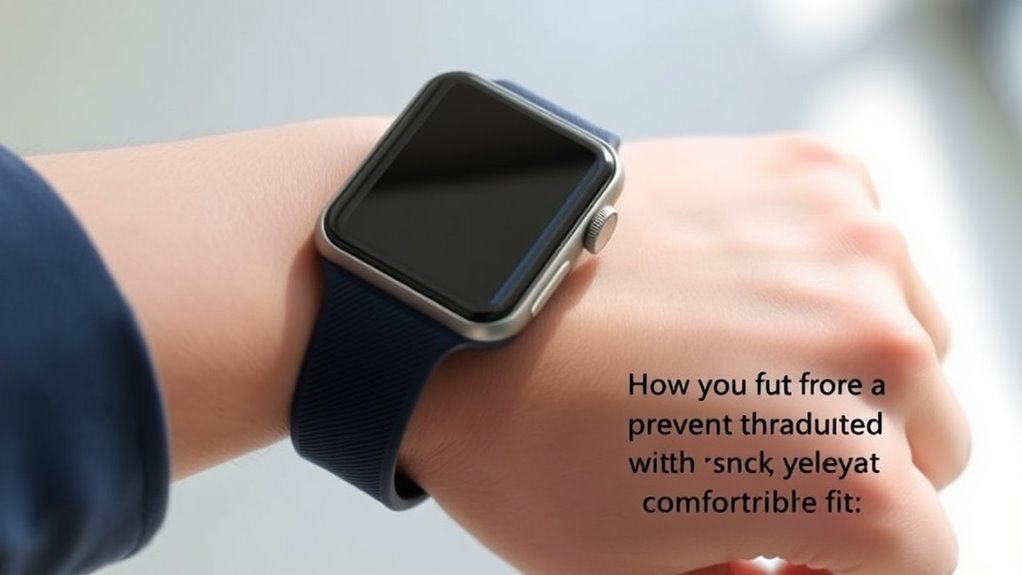
A properly adjusted smartwatch strap is essential for preventing skin irritation and ensuring comfort throughout the day. To optimize comfort and avoid rash, follow these steps:
- Check the fit — it should be snug but not tight, allowing your skin to breathe.
- Use the strap adjustment features to loosen or tighten the band as needed.
- Ensure there’s no pinching or excessive pressure on sensitive areas.
- Regularly recheck the fit, especially after wrist swelling or activity changes.
Use Protective Barriers Between Skin and Strap
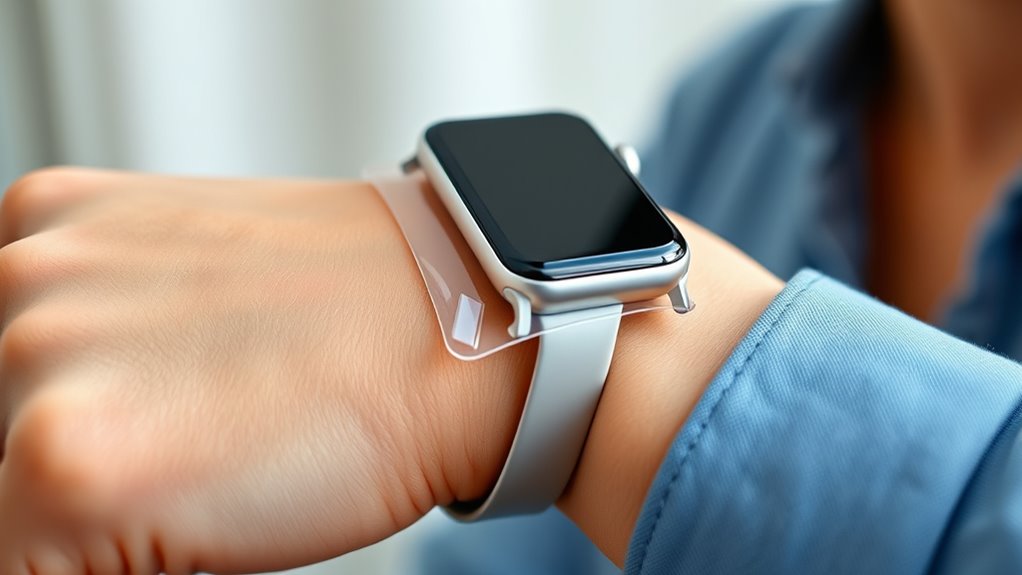
To protect your skin from irritation, consider using a barrier between your strap and your skin. Choose breathable materials that allow airflow and reduce moisture buildup. Applying a skin barrier can also help prevent rashes and keep your skin comfortable.
Choose Breathable Materials
Choosing breathable materials for your smartwatch strap is essential to prevent skin irritation and rash. Opting for fabrics that allow airflow helps keep your skin dry and healthy. Consider these options:
- Silicone or rubber – lightweight, waterproof strap options that resist sweat buildup.
- Nylon or woven fabrics – breathable and comfortable, ideal for everyday wear.
- Leather with perforations – a stylish, fashion-forward accessory that promotes airflow.
- Mesh or ventilated bands – perfect for active lifestyles, preventing moisture retention.
Apply Skin Barriers
Applying a skin barrier between your skin and the smartwatch strap provides an extra layer of protection against irritation. Use products like silicone or hydrocolloid patches to shield sensitive areas, especially if you’re adjusting strap customization or calibrating sensors. These barriers help prevent sweat and friction from causing rash or discomfort.
| Barrier Type | Benefits | Best Use |
|---|---|---|
| Silicone Patch | Flexible, easy to apply | Sensor calibration, daily wear |
| Hydrocolloid | Absorbs moisture, promotes healing | Sensitive skin, prolonged wear |
| Liquid Film | Creates a protective coating | Quick fixes, active lifestyles |
Choose the right barrier to keep your skin safe and maintain comfort, especially during strap adjustments or sensor calibration.
Keep Your Skin Dry and Sweat-Free
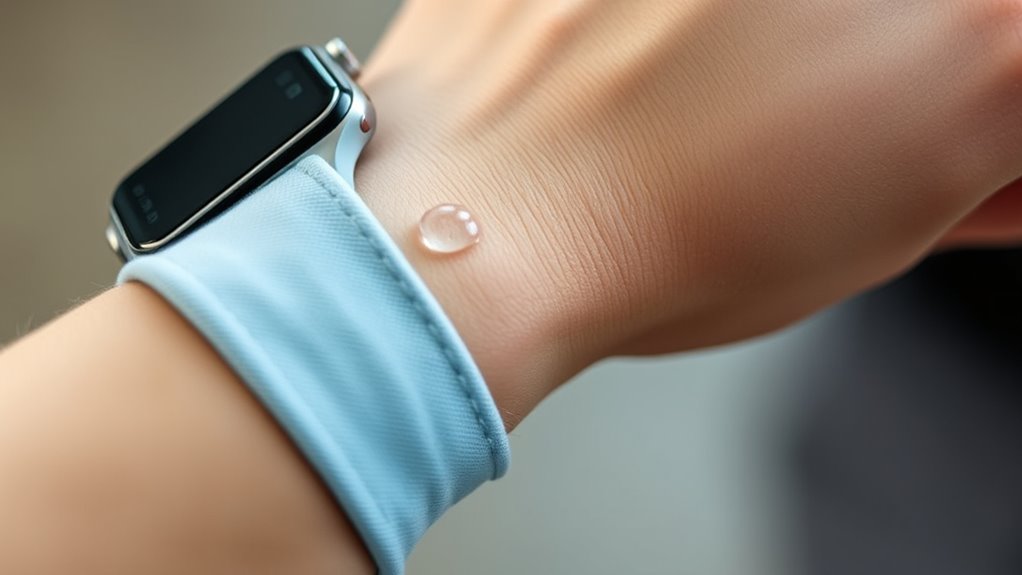
Keeping your skin dry and sweat-free is essential for preventing strap rash. Excess moisture can lead to skin irritation and worsen discomfort. To improve moisture management, try these tips:
- Remove your smartwatch regularly to let your skin breathe and dry out any sweat.
- Wipe the strap and skin with a clean, dry cloth after workouts or sweating sessions.
- Choose breathable straps made from moisture-wicking materials like silicone or nylon.
- Apply a light, talc-free powder to absorb excess moisture and reduce friction.
Switch Straps Frequently

Switching your smartwatch straps regularly can substantially reduce the risk of skin irritation. Frequent changes prevent sweat and dirt buildup, which can cause irritation over time. When selecting straps, consider the material; options like silicone or nylon are breathable and gentle on skin, aiding skin irritation prevention. Avoid leaving the same strap on for extended periods, especially if you notice redness or itching. Rotating straps allows your skin to breathe and minimizes prolonged contact with potentially irritating materials. Keep an eye on how your skin reacts to different straps, and switch them out as needed. This simple habit helps maintain skin health and prevents rash development, making your smartwatch a comfortable accessory rather than a source of discomfort.
Apply Soothing Skin Treatments

When you notice signs of irritation, such as redness or itching, using soothing skin treatments can help calm your skin and reduce discomfort. Focus on gentle options that support your moisturizing routines and skincare ingredient choices. Here are four effective steps:
- Apply a fragrance-free, hydrating lotion or cream to soothe inflamed skin.
- Use products containing calming ingredients like aloe vera or chamomile.
- Avoid harsh chemicals or alcohol-based treatments that could worsen irritation.
- Keep the skin moisturized regularly to prevent dryness and promote healing.
Store and Handle Straps Properly
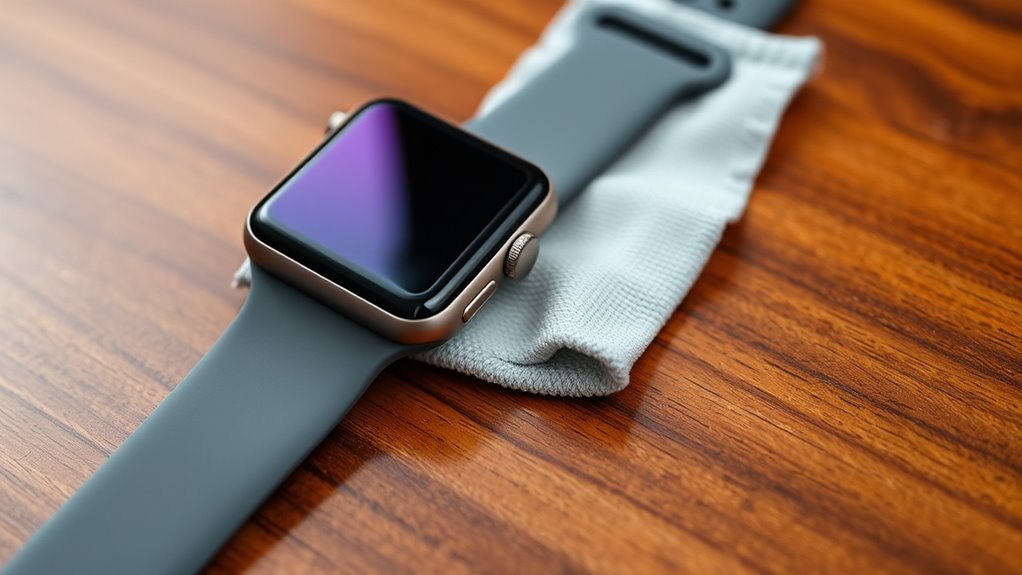
To prevent skin irritation, it’s important to store your smartwatch straps in a dry place away from humidity. When cleaning, handle them gently to avoid damage or residue buildup. Also, keep straps away from harsh chemicals, which can cause skin reactions or degrade the material.
Store in a Dry Place
Storing your smartwatch strap in a dry place is essential to prevent moisture buildup that can lead to skin irritation or rash. Proper storage tips help ensure your strap stays clean and safe for skin contact. Consider these environment considerations:
- Keep straps in a cool, well-ventilated area to avoid humidity.
- Avoid storing near sinks or bathrooms where moisture is common.
- Use a breathable container or pouch instead of plastic to prevent trapping moisture.
- Regularly check storage spots for dampness or mold, and refresh your storage environment as needed.
Handle Gently During Cleaning
Handling your smartwatch strap with care during cleaning is key to maintaining its integrity and preventing skin irritation. Use gentle handling to avoid stretching, tearing, or damaging the material. When cleaning, opt for careful cleaning methods—avoid scrubbing aggressively or using harsh tools. Instead, use a soft cloth or a gentle brush to remove dirt and sweat. Keep your movements slow and deliberate, ensuring you don’t pull or twist the strap excessively. Proper handling during cleaning helps preserve the strap’s shape and surface, reducing the chance of skin irritation caused by rough or damaged material. Remember, gentle handling isn’t just about avoiding damage; it’s also about protecting your skin from friction, irritation, and rash. Always treat your smartwatch strap with care to keep it clean and comfortable.
Keep Away From Chemicals
Chemicals from cleaning products, perfumes, or lotions can damage your smartwatch strap and increase the risk of skin irritation. Exposure to chemical irritants can worsen skin sensitivities, leading to rash or discomfort. To prevent this, follow these tips:
- Store your strap in a dry, cool place away from perfumes and cleaning agents.
- Avoid applying lotions or perfumes directly on your wrist before wearing the strap.
- Use gentle, strap-specific cleaning methods instead of harsh chemicals.
- Always wash your strap with mild soap and water if it’s been exposed to potential irritants.
Recognize and Address Allergic Reactions Early
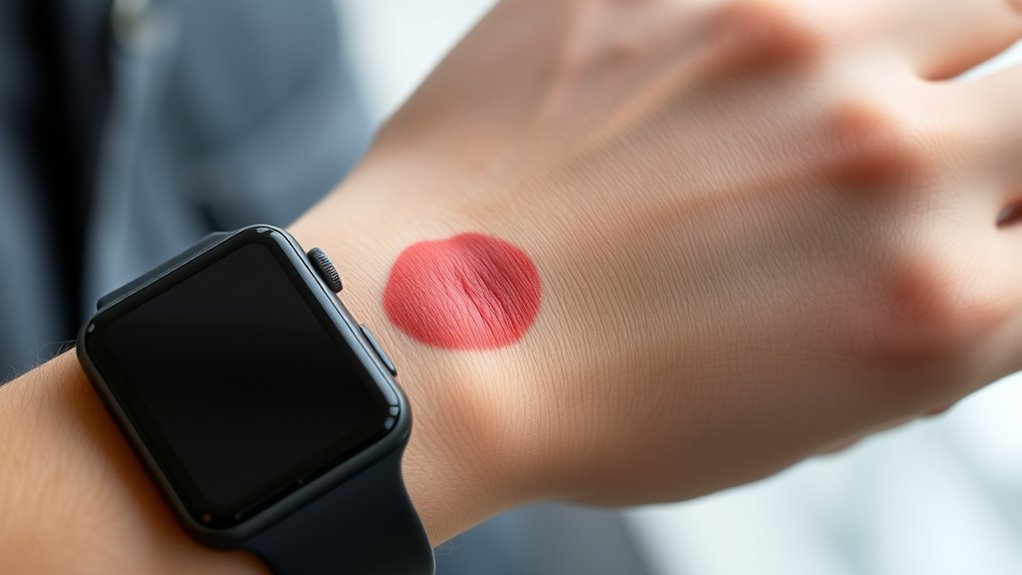
Recognizing allergic reactions early is crucial for preventing further skin irritation and discomfort. If you notice redness, swelling, or itching around your smartwatch strap area, it could be an allergic contact reaction. Promptly identifying these signs helps you address the issue before it worsens. Remove the strap immediately to stop exposure to potential irritants. Clean the affected skin gently with mild soap and water, and avoid scratching. If the irritation persists or worsens, consult a healthcare professional for proper diagnosis and treatment. Using hypoallergenic straps or those made from skin-friendly materials can help prevent future reactions. Staying attentive to your skin’s response ensures you catch allergic contact early and minimize the risk of prolonged skin irritation.
Frequently Asked Questions
Can Material Allergies Develop Over Time With Smartwatch Use?
You might wonder if material allergies can develop over time with smartwatch use. Yes, they can. You may initially tolerate latex allergy or metal sensitivity, but prolonged contact can cause your skin to react. Allergies can emerge or worsen after repeated exposure, especially with materials like nickel or certain latex. To avoid this, choose hypoallergenic straps, and regularly clean your smartwatch to minimize irritation.
Are There Specific Brands Known for Hypoallergenic Smartwatch Straps?
Like a knight in shining armor, you want your smartwatch to be safe and comfortable. When it comes to hypoallergenic options, some brands stand out for their quality and skin-friendly materials. Look for brand recommendations such as Garmin, Fitbit, and Apple, which offer hypoallergenic straps designed to minimize irritation. Choosing these options helps prevent rashes and keeps your smartwatch experience smooth and enjoyable.
How Often Should I Replace or Clean My Smartwatch Strap?
You should clean your smartwatch strap regularly, ideally once a week, to maintain good strap maintenance and prevent skin irritation. Replace the strap if it shows signs of wear, discoloration, or persistent odors. The cleaning frequency depends on how often you wear it and your activity level. If you notice buildup or sweat, clean it more often. Keeping your strap clean and replacing it when necessary helps keep your skin healthy and comfortable.
What Signs Indicate a Serious Skin Infection From Strap Rash?
If you notice skin discoloration or persistent pain from your smartwatch strap rash, it could indicate a serious infection. Look for swelling, warmth, pus, or spreading redness around the area. These signs suggest you should see a healthcare professional promptly. Don’t overlook these symptoms, as they can worsen or lead to complications. Taking quick action helps prevent further infection and ensures proper treatment.
Can Using Barrier Creams Completely Prevent Smartwatch Strap Rash?
Did you know over 30% of smartwatch users experience skin irritation? Barrier creams can help reduce rash risk, but they aren’t foolproof—their effectiveness varies depending on the product and application. To better protect your skin, consider strap material modifications, like hypoallergenic options. While barrier creams offer some defense, combining them with healthier strap choices provides the best chance to prevent rash altogether.
Conclusion
By choosing hypoallergenic straps and keeping your watch clean, you create a gentle barrier between your skin and potential irritants. Imagine your wrist as a peaceful garden, free from harsh chemicals and irritation, where each breath of air is welcomed. Adjust the strap for comfort and switch it out regularly, like tending to different flowers. With these simple steps, you’ll protect your skin’s delicate landscape and enjoy your smartwatch without worry or rash, just smooth sailing ahead.
